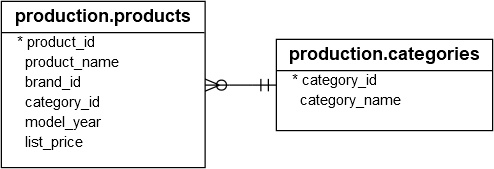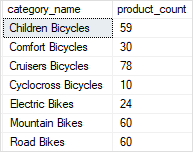Summary: in this tutorial, you will learn how to use the SQL Server PIVOT operator to convert rows to columns.
Setting up the goals
For the demonstration, we will use the production.products and production.categories tables from the sample database:

The following query finds the number of products for each product category:
SELECT
category_name,
COUNT(product_id) product_count
FROM
production.products p
INNER JOIN production.categories c
ON c.category_id = p.category_id
GROUP BY
category_name;
Code language: SQL (Structured Query Language) (sql)Here is the output:

Our goal is to turn the category names from the first column of the output into multiple columns and count the number of products for each category name as the following picture:

In addition, we can add the model year to group the category by model year as shown in the following output:

Introduction to SQL Server PIVOT operator
SQL Server PIVOT operator rotates a table-valued expression. It turns the unique values in one column into multiple columns in the output and performs aggregations on any remaining column values.
You follow these steps to make a query a pivot table:
- First, select a base dataset for pivoting.
- Second, create a temporary result by using a derived table or common table expression (CTE)
- Third, apply the
PIVOToperator.
Let’s apply these steps in the following example.
First, select category name and product id from the production.products and production.categories tables as the base data for pivoting:
SELECT
category_name,
product_id
FROM
production.products p
INNER JOIN production.categories c
ON c.category_id = p.category_id
Code language: SQL (Structured Query Language) (sql)Second, create a temporary result set using a derived table:
SELECT * FROM (
SELECT
category_name,
product_id
FROM
production.products p
INNER JOIN production.categories c
ON c.category_id = p.category_id
) t
Code language: SQL (Structured Query Language) (sql)Third, apply the PIVOT operator:
SELECT * FROM
(
SELECT
category_name,
product_id
FROM
production.products p
INNER JOIN production.categories c
ON c.category_id = p.category_id
) t
PIVOT(
COUNT(product_id)
FOR category_name IN (
[Children Bicycles],
[Comfort Bicycles],
[Cruisers Bicycles],
[Cyclocross Bicycles],
[Electric Bikes],
[Mountain Bikes],
[Road Bikes])
) AS pivot_table;
Code language: SQL (Structured Query Language) (sql)This query generates the following output:

Now, any additional column which you add to the select list of the query that returns the base data will automatically form row groups in the pivot table. For example, you can add the model year column to the above query:
SELECT * FROM
(
SELECT
category_name,
product_id,
model_year
FROM
production.products p
INNER JOIN production.categories c
ON c.category_id = p.category_id
) t
PIVOT(
COUNT(product_id)
FOR category_name IN (
[Children Bicycles],
[Comfort Bicycles],
[Cruisers Bicycles],
[Cyclocross Bicycles],
[Electric Bikes],
[Mountain Bikes],
[Road Bikes])
) AS pivot_table;
Code language: SQL (Structured Query Language) (sql)Here is the output:

Generating column values
In the above query, you had to type each category name in the parentheses after the IN operator manually. To avoid this, you can use the QUOTENAME() function to generate the category name list and copy them over the query.
First, generate the category name list:
DECLARE
@columns NVARCHAR(MAX) = '';
SELECT
@columns += QUOTENAME(category_name) + ','
FROM
production.categories
ORDER BY
category_name;
SET @columns = LEFT(@columns, LEN(@columns) - 1);
PRINT @columns;
Code language: SQL (Structured Query Language) (sql)The output will look like this:
[Children Bicycles],[Comfort Bicycles],[Cruisers Bicycles],[Cyclocross Bicycles],[Electric Bikes],[Mountain Bikes],[Road Bikes]Code language: CSS (css)In this snippet:
- The
QUOTENAME()function wraps the category name by the square brackets e.g.,[Children Bicycles] - The
LEFT()function removes the last comma from the @columns string.
Second, copy the category name list from the output and paste it to the query.
Dynamic pivot tables
If you add a new category name to the production.categories table, you need to rewrite your query, which is not ideal. To avoid doing this, you can use dynamic SQL to make the pivot table dynamic.
In this query, instead of passing a fixed list of category names to the PIVOT operator, we construct the category name list and pass it to an SQL statement, and then execute this statement dynamically using the stored procedure sp_executesql.
DECLARE
@columns NVARCHAR(MAX) = '',
@sql NVARCHAR(MAX) = '';
-- select the category names
SELECT
@columns+=QUOTENAME(category_name) + ','
FROM
production.categories
ORDER BY
category_name;
-- remove the last comma
SET @columns = LEFT(@columns, LEN(@columns) - 1);
-- construct dynamic SQL
SET @sql ='
SELECT * FROM
(
SELECT
category_name,
model_year,
product_id
FROM
production.products p
INNER JOIN production.categories c
ON c.category_id = p.category_id
) t
PIVOT(
COUNT(product_id)
FOR category_name IN ('+ @columns +')
) AS pivot_table;';
-- execute the dynamic SQL
EXECUTE sp_executesql @sql;
Code language: SQL (Structured Query Language) (sql)In this tutorial, you have learned how to use the SQL Server PIVOT table to convert rows to columns.